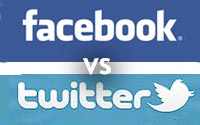
Facebook and Twitter have
emerged as the two leading social media platforms, but marketers are still figuring out what types of campaigns work best on each. The fact that both companies are still rolling out new ad formats and
tools doesn’t make that any easier.
But new research from SocialCode, the social media marketing firm and Washington Post Co. subsidiary, compares advertising efforts on Facebook to
Twitter. In short, the study finds that the two social properties are complementary because they have very different purposes requiring different advertising approaches.
Facebook users are
typically connecting around their personal lives by posting photos, talking with friends and sharing opinions, those on Twitter are usually spreading news about outside events in real-time.
Based on one campaign for a media client, for example, SocialCode found that the most responsive of eight user categories targeted on Facebook -- food and social media -- were the lowest-performing
on Twitter. Conversely, the two highest-performing categories on Twitter -- entertainment and sports -- were the lowest ones on Facebook.
SocialCode also compared separate campaigns for a
financial services brand and a media company on Facebook and Twitter. The former involved an 11-day promotion in April in which the client wanted to drive fans and followers, respectively, to sign up
for a peer-to-peer payment system at as low a customer cost-per-acquisition as possible.
Signing up for an account included the chance to win money, and ads on Facebook and Twitter both
pointed to a brand’s Facebook Connect enrollment page. Facebook delivered a higher conversion rate (2.5% v. 1.5%), as well as a lower cost-per-acquisition, at about $65 compared to $90 on
Twitter.
What was the difference? “It appears the biggest contributor to the higher conversion on Facebook was the consistency in the user experience. By keeping the user within the
Facebook walls, they were more likely to complete the offer,” read the study.
For the media company campaign, the client wanted to use Facebook and Twitter to increase sign-ups for its
news app. The ads on both social sites drove users’ to its Facebook app page, but the Facebook campaign last five months, while the Twitter effort was only two months. In this case, Twitter
delivered a higher conversion rate (15% vs. about 8%) and lower cost-per-acquisition ($10 vs. $20).
SocialCode said the main reason for the better results on Twitter was “audience
fatigue” on Facebook, since users were targeted with ads three months prior to Twitter. Over the longer campaign on Facebook, the response rate diminished while driving up the cost per new
customer.
Regardless of platform, the social marketing firm advises marketers to build up user communities before launching advertising on Facebook or Twitter, since brand adherents are more
likely to act on offers than others. A brand’s Twitter followers are five times more likely to accept offers than non-followers, while Facebook fans are two to five times more likely to do so,
per Social Code's research.